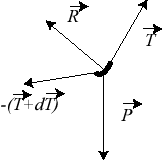| next curve | previous curve | 2D curves | 3D curves | surfaces | fractals | polyhedra |
CATENARY OF A SURFACE
| Notion studied by Bobillier in 1829.
See: Paul Appell: cours de mecanique rationnelle, page 220. |
| Differential equation: |
The catenaries of a surface are the equilibrium lines of an inelastic flexible homogeneous infinitely thin massive wire included in the surface, placed in a uniform gravitational field.
The catenaries are also the curves that minimize the altitude of their center of gravity, which means that the catenary with length l that joins A and B is, among all the homogeneous curves with length l joining A and B traced on the surface, the one with center of gravity at the lowest altitude.
Here is the derivation of the above differential equation:
| We write the force equilibrium relation for a small element of the wire: vector tangent to the curve). But applying the Binet formulas, we get: |
 |
Examples:
- the catenaries of a non horizontal plane are the usual catenaries.
- the catenaries of any vertical cylinder are the curves that develop into catenaries with vertical axis.
- the cylindrical catenaries
- the conical catenaries
- the spherical catenaries
| next curve | previous curve | 2D curves | 3D curves | surfaces | fractals | polyhedra |
© Robert FERRÉOL 2018